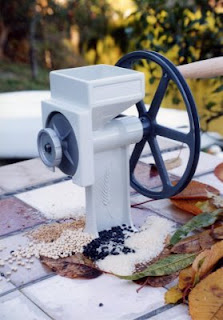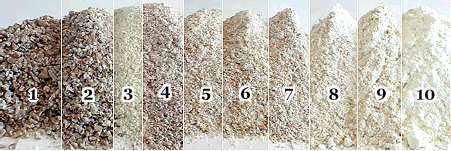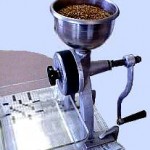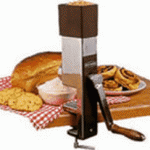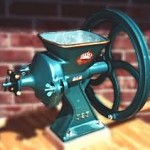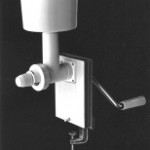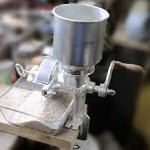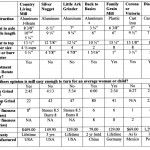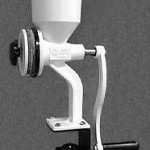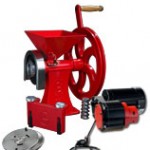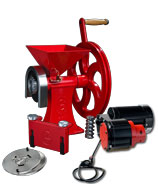 Back overseas, I still wanted and needed a good mill. With a kind tip from Lehman’s Hardware, who sell the Diamant in the USA, I was able to contact the Diamant D.525 mill manufacturer in Denmark (this was in 2003; now the Diamant is made in Poland and is sold by a different outfit overseas. Lehman’s still carries them in the USA, but at over $1200 plus shipping! The price is so high because of the dollar being currently weak against the Euro. In 2003, I was able to buy the mill in Europe for about $350, when the dollar was much stronger against the Euro.
Back overseas, I still wanted and needed a good mill. With a kind tip from Lehman’s Hardware, who sell the Diamant in the USA, I was able to contact the Diamant D.525 mill manufacturer in Denmark (this was in 2003; now the Diamant is made in Poland and is sold by a different outfit overseas. Lehman’s still carries them in the USA, but at over $1200 plus shipping! The price is so high because of the dollar being currently weak against the Euro. In 2003, I was able to buy the mill in Europe for about $350, when the dollar was much stronger against the Euro.
It is a monster of a mill, the largest of the Big Three. It has the largest burrs at 5.25″. That doesn’t sound much bigger than 5″, but that equates to 10% more grinding surface, which means 10% more throughput in theory. The whole mill is cast iron, designed and built to last forever, as far as I can tell. The cast iron has been painted inside and out, and the mill is attractive, in an old-fashioned way. The flywheel is the largest of the Big Three, and by far the heaviest. The mill has no ball bearings, but it doesn’t seem to need them. It seems to be the easiest of the Big Three to keep it going, probably because of the leverage of the large diameter flywheel and also because of its weight, which gives momentum. I can grind hard wheat into a fine flour with one hand, but I have to change hands every 25 revolutions. With two hands, I can grind all day. In practice, the mill has very good throughput, and it only takes a few minutes to get enough fine flour for a loaf of bread or a batch of pasta.
The Diamant allows easy and precise adjustment of the grind, and there is a positive, hand-operated lock ring that keeps the setting right where you set it. There is no slippage on this mill. The only augur is a large grain-busting screw augur. It seems to work fine for all materials, and it moves everything out towards the burrs. No material is left in the bottom of the grinding chamber, so it is easy to start grinding another material without contaminating it with the former material. The cast iron burrs grind flour as finely as any of the Big Three. One can buy specialty burrs; in addition to the standard (fine) burrs, you can get coarse and extra fine, each at extra cost, about $130 (2010 prices). I have no experience with coarse or extra fine burrs.
The dust cover that covers the burrs and contains the setting mechanism comes off in seconds after loosening two thumb nuts. The front burr slides off the main shaft, then three screws hold the rear burr, as in the Country Living mill. If I ever wanted to give the inside a good cleaning, I’d need a screwdriver handy. The mill comes with a free screwdriver, so that’s not a problem. I don’t do peanut butter or grind other oily materials with the Diamant, so I haven’t had to clean it. It would easily do those materials, but I can’t get organic peanuts over there, so I don’t. Like the Country Living mill, the Diamant’s flywheel has a “V” to allow you to motorize it some day. I hope I never have to, but I can.

Diamant D.525 Problems
There are a few problems with the Diamant. It has a comfortable two-fisted handle, but as I wrote above under the Country Living mill, you have to watch where you put the mill to avoid catching the handle in your groin as you walk past. The mill is very heavy, so you need something substantial to bolt it to (no clamp is available, nor could I imagine one strong enough to hold it down). It is also the largest of the Big Three, meaning a little more trouble finding a spot for it. Lastly, it is impossibly expensive in the USA. Except for the cost, these few problems are surmountable, and I am very happy with the Diamant. It can grind anything to fine powder, it is easy to turn, and it just keeps going and going.
So, I had my good mill in the overseas house, but I still needed a good mill here in the USA apartment. I wasn’t excited about the Country Living mill for the reasons mentioned above, and I couldn’t afford the cost or the space requirements of the Diamant. I thought I was stuck. I borrowed my friend’s Country Living mill and tried it again. I wanted to like it; what other choice did I have? It still made good flour, but now, a few years after I first used it, the mill was getting harder to turn at the fine setting. I looked at the burrs, and they were showing some wear. That wear translates to more friction, which means more effort to turn the handle and more heat generated during grinding. Heat is our enemy when grinding fresh grains. Enough heat can denature the natural oils of the grain. I also got reacquainted with the problems I mentioned above. So, I wanted to like this mill, but I couldn’t. I started another search, and I found my answer: The GrainMaker mill!
Original Review done by Craig MacDonald.
